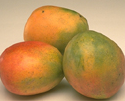Skip over navigation




There are some open markets in England that would like to sell fruit by their weight in lbs (pounds), but we often buy them in kilos.
0.45 kilo = 1 lb
2.20 lb = 1 kilo
You get about 4 apples or 4 bananas in one pound (1 lb).
So, roughly, what would 6 bananas and 4 apples together weigh in kilos?
You get about 6 mangoes in a kilo.
So, roughly, what would 30 mangoes weigh in pounds (lbs)?
You get about 6 oranges in one pound (1 lb).
So, roughly, what would 20 oranges weigh in kilos?


Or search by topic
Number and algebra
Geometry and measure
Probability and statistics
Working mathematically
Advanced mathematics
For younger learners
Weighing Fruit
Age 7 to 11
Challenge Level 





- Problem
- Getting Started
- Student Solutions
- Teachers' Resources
Weighing Fruit




There are some open markets in England that would like to sell fruit by their weight in lbs (pounds), but we often buy them in kilos.
0.45 kilo = 1 lb
2.20 lb = 1 kilo
You get about 4 apples or 4 bananas in one pound (1 lb).
So, roughly, what would 6 bananas and 4 apples together weigh in kilos?
You get about 6 mangoes in a kilo.
So, roughly, what would 30 mangoes weigh in pounds (lbs)?
You get about 6 oranges in one pound (1 lb).
So, roughly, what would 20 oranges weigh in kilos?
Why do this problem?
This problem will help pupils gain some awareness of different weight measures and introduces them to the idea of conversion between units of measure.
Possible approach
You could start off by sharing some food labels and packets with children which exemplify different units of weight. Encourage children to comment on what they notice about the weights, and in conjunction with some balances and/or scales, talk about the different units. In addition to discussing metric vs imperial systems, you can also use this opportunity to gain an insight into what pupils
already know about converting between the two.
The idea of working out roughly, or estimating, the sort of size of answer you're expecting is very useful in these situations as it might prevent children from blindly carrying out any operation, rather than thinking about making sense of the information. Having talked about the first question as a whole group, children should be able to have a go at the other two parts of the problem in
pairs.
Key questions
Is a kilo bigger, the same, or smaller than a pound? How do you know?
How much would 4 apples weigh in kilos?
So, how can we find the answer to the first question? What would you like to do?
How much do 6 oranges weigh in pounds?
So, how can we find the answer to the second question? What would you like to do?
Possible extension
Encourge the pupils to create their own problems based on the information given.
Possible support
Having balances and scales available for pupils to get a sense of the conversions would be helpful, and this might allow them to check that their answers seem reasonable too.You may also like
Watching the Wheels Go 'round and 'round
Use this information to work out whether the front or back wheel of this bicycle gets more wear and tear.
A Day with Grandpa
Grandpa was measuring a rug using yards, feet and inches. Can you help William to work out its area?

